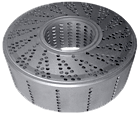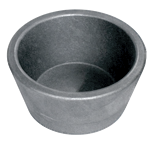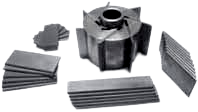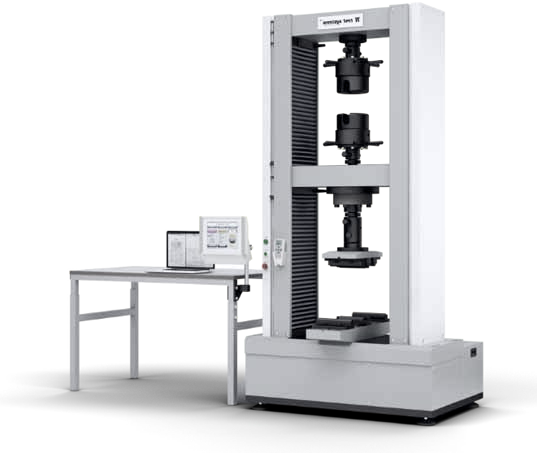Isostatic graphite
ISOSTATIC GRAPHITE

1 It is produced from a mixture of coke and pitch by means of isostatic molding, followed then by heat-treating the blank to a temperature of 2500-2800 °C.
2 It is designed to meet the strict requirements for materials used in advanced equipment production.
3 It is able to replace traditional types of structural graphite, featuring increased service life and performanc.
COMPARISON OF STRUCTURAL GRAPHITE BLANK MOLDING METHODS
PIERCING MOLDING (GMZ)

- High Performance
- Large Blank Dimensions
- Low Product Durability
- High Property Anisotropy (dependent on orientation)
BLANK DIE MOLDING (MPG, ARV, MGZ)

- Increased Product Durability
- Fine Grain Size
- Small Blank Dimensions
- Property Anisotropy (dependent on orientation)
- Low Performance
ISOSTATIC MOLDING (IG-1S, IG-2H)

- High Product Durability
- Large Blank Dimensions
- Fine Grain Size
- Isotropy of Properties (not dependent on orientation)
- Low Performance
ANISOTROPY OF GRAPHITE PROPERTIES
NON-ISOSTATIC GRAPHITE
Preferred molding direction
Molding axis
The properties of blanks, and the products made from them, depend on their orientation
The durability and electrical conductivity perpendicular to the molding axis are lower

ISOSTATIC GRAPHITE

No preferred molding direction
No molding axis
The properties of the blanks and products made from them DO NOT depend on orientation
Durability and electrical conductivity are the same regardless of orientation
APPLICATION
MECHANICAL ENGINEERING, GLASS PRODUCTION
| ISOSTATIC | IG-2H |
| IG-1S | |
| BLANK DIE |
MPG-7 |
| ARV, MG | |
| PIERCING | GMZ |






Advantages of isostatic graphite:
- High density
- Fine grain size
- A previously unattainable surface finish and a complex product geometry
- Increased chemical and oxidative resistance
- Increased chemical and oxidative resistance
APPLICATION
VACUUM FURNACES, METALLURGY
| ISOSTATIC | IG-2H |
| IG-1S | |
| BLANK DIE |
MPG-7 |
| ARV, MG | |
| PIERCING | GMZ |





Advantages of isostatic graphite:
- Electrical resistance, durability, and other properties do not depend on orientation
- The possibility to produce 3D heaters for vacuum furnaces
- Increased chemical and oxidative resistance
- High thermal shock resistance
- Low abrasion and long service life
APPLICATION
MECHANICAL ENGINEERING, METALLURGY, CHEMICAL INDUSTRY
| ISOSTATIC | IG-2H |
| IG-1S | |
| BLANK DIE |
MPG-7 |
| ARV, MG | |
| PIERCING | GMZ |






Advantages of isostatic graphite:
- The production of large-sized products with thin walls or complex shapes
- Increased service life of products operating under high load
- High thermal stability
COMPARISON OF ISOSTATIC GRAPHITE WITH TRADITIONAL GRAPHITE TYPES
| Indicators | Piercing molding graphite | BLANK die molding | Isostatic graphite | ||||
|---|---|---|---|---|---|---|---|
| GMZ | ARV, MG | MPG-7 | IG-1S | IG-2H | |||
| // | / | // | / | ||||
| Maximum blank dimensions, mm | Ø500×1800 | Ø200×500 | 200²×100 | Ø600×1200 | |||
| Bulk density, g/cm³ | 1,68–1,88 | 1,70–1,78 | 1,70–1,80 | 1,72–1,77 | 1,75–1,80 | ||
| Compressive strength, MPa | 30–50 | 25–45 | 40–65 | 37–60 | 65–90 | 45–60 | 80–100 |
| Flexural Strength, MPa | 12–25 | 10–18 | 15–25 | 13–20 | 35–50 | 25–35 | 40–50 |
| Ash content, % | 0,01–0,02 | 0,01–0,02 | 0,01–0,25 | 0,01–0,02 | |||
| Specific electrical resistance, µΩ•m | 5–8 | 6–9 | 9–16 | 10–18 | 12–18 | 12–16 | 14–18 |
| Average filler grain size, µm | 130 | 50 | 40 | 50 | 25 | ||
| Porosity, % | 20–18 | 18–23 | 12–15 | 18–20 | 16–19 | ||
PRECISION OF PRODUCTION TECHNOLOGY
ISOSTATIC GRAPHITE PRODUCTION IS CHARACTERIZED BY:
1 Strict requirements as to the quality of raw materials;
2 Close compliance with process parameters and component dosage;
2
The use of advanced equipment.
The control of each blank throughout the entire production cycle using advanced control methods.
ADVANTAGES:
1 High stability of graphite properties;
2 Extremely low shipment probability of a product with hidden flaws.
CONCLUSIONS:
1 It Is possible to manufacture large batches of graphite products with stable properties;
2 It is possible to manufacture products meeting increased requirements for uptime.
QUALITY ANALYSIS METHODS
We have methods and equipment for measuring the following graphite properties according to GOST standards:
- Compressive / flexural strength
- Ash impurity content
- Specific electrical resistance
- Actual density
- Rockwell hardness
- Thermal conductivity
- Tensile strength
- Elasticity modulus

CONCLUSIONS
1 Isostatic graphite is the most advanced material in the graphite industry and has been recommended to replace traditional grades of structural graphite.
2 The advantages of isostatic graphite compared to traditional grades are: higher stability and volumetric uniformity of product properties.
- Large blank dimensions: up to Ø600×600 mm (in 2018: up to Ø600×1200 mm).
- High strength, thermal stability and abrasion resistance comparable or even higher than that of MPG graphite grade.
- Fine grain size and density; high chemical and oxidative resistance.
PRODUCTION FLOW CHART

ISOSTATIC GRAPHITE PROPERTIES
Advantages of isostatic graphite in comparison with typical kinds of artificial graphite:
- Uniform structure and low porosity
- Isotropic properties
- High density and high mechanical strength
- High thermal, chemical and oxidative resistance
- Low ash content

| Indicators | Values per grade | |
|---|---|---|
| IG-1S | IG-2H | |
| Average filler grain size, µm | 50 | 25 |
| Bulk density, g/cm³ | 1,72–1,77 | 1,75–1,80 |
| Compressive strength, MPa | 45–60 | 80–100 |
| Flexural Strength, MPa | 25–35 | 40–50 |
| Ash content, % | 0,01–0,1 | |
| Specific electrical resistance, µΩ•m * | 12–16 | 14–18 |
| Thermal coefficient of linear expansion, 10–6 K–1 | 3–5 | |
| Thermal conductivity, W/m·K * | 50–70 | 80–100* |
| Porosity, % | 17–20 | 16–18 |
| Overall graphite blank dimensions, mm * | Ø(300–600)×(600–1200) | |